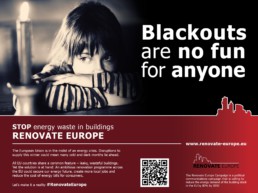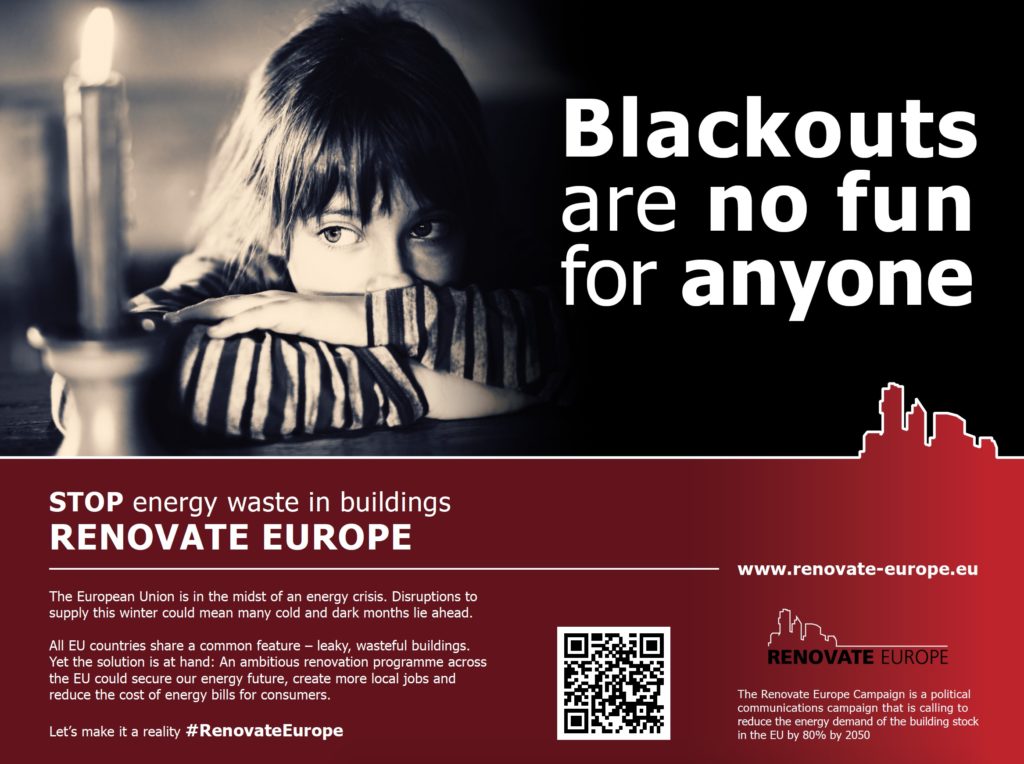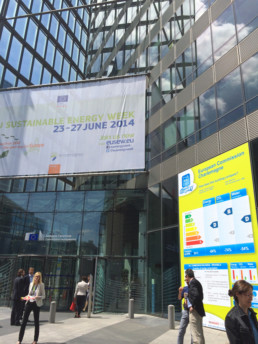Letter to Mr. Juncker, President of the European Commission and Mr. Šefčovič, Vice-President The Energy Union - Spotlight on energy renovation of buildings
We write to you ahead of the important debate of the College of Commissioners on the Energy Union in order to urge you to build the future over-arching framework of our energy policy on solid ground, thus to firmly place actions to stop the huge energy waste in our existing building stock at the core of the concept.
New Commission must prioritise building renovation: Renovate Europe Day shows buildings crucial for energy security, jobs, climate and growth
Highest leverage, quickest roll-out and widest societal benefits: Ambitious building renovation projects are best-in-class for Strategic Investment
“European Fund for Strategic Investments must earmark funds for deep renovation projects” says building sector industry
A new report published today by Copenhagen Economics concludes that deep building renovation projects respond more effectively and cost-efficiently to the key operational objectives of the European Fund for Strategic Investments (EFSI), and recommends a project selection process providing priority to “shovel ready” investments with a quick roll-out and high rate of return on societal benefits.
The building sector industry associations Eurima, Glass for Europe, EuroACE, PU Europe and the Renovate Europe Campaign welcome this report as a clear sign that building refurbishment is one of the smartest, most cost-effective ways of mobilising investments for growth.
“The European Strategic Investment Fund aims to give priority to projects that boost short and medium-term activity while providing high returns to society” said Adrian Joyce, Secretary General of EuroACE and Renovate Europe Campaign Director “and this report shows that building renovation can respond very effectively to all these requirements”
“Energy infrastructure-related projects are often put on the table when thinking of EFSI projects” added Bertrand Cazes, Secretary General of Glass for Europe “but building renovation projects should be given high priority if we take our building stock as an essential part of our energy infrastructure”.
“These substantial benefits should be recognised in the section criteria proposed in the EFSI operation” added Oliver Loebel, Secretary General of PU Europe “Relatively ‘shovel ready’ investments which can be quickly deployed and provide substantial societal returns must be given priority”.
“Both research and real experiences” added Jan te Bos, Eurima Director-General “have demonstrated that deep renovation of buildings are fully adapted to the main EU priorities: they reduce GHG emissions and import dependence, and provide great returns in terms of growth and jobs, as recognised in the recently adopted Energy Union Strategy. The EU Institutions must follow suit by ring-fencing a sub-fund in the EFSI which would be devoted to investments on large, deep renovation programmes”.
Display Poster on the Charlemagne Building during EUSEW!
June 2014
Giant-size Poster on Charlemagne Building reveals energy consumption of Commission buildings
In partnership with Renovate Europe and Energy Cities, the Commission, though its Office for Infrastructure and Logistics in Brussels (OIB), will partake in a highly visible communication action during the EU Sustainable Energy Week (EUSEW – 23-27 June) by presenting a giant-size Display Campaign poster on the Charlemagne building highlighting the energy consumption of Commission buildings.
“The average energy consumption per square meter for the Commission buildings in Brussels has decreased by more than 30% between 2005 and 2013, which is more than 4% per year, and that is just the beginning!” explained Marc Seguinot, Head of Unit in the OIB, responsible for the management of the Commission's buildings. “Such significant results have encouraged us to go further, and we have planned for major renovation of Commission buildings from 2019. I hope this will inspire other public administrations to follow in the same lead”.
The recently adopted Energy Efficiency Directive (2012/27/EU) requires Member States to renovate 3% every year of their buildings owned and occupied by the central governments. The Commission has committed itself to reach the same result.
“This is a good example of a public administration which has put in place a coherent set of long-term energy efficiency measures to STOP energy waste in its buildings, and has reached a 4% reduction in energy consumption per year,” said Adrian Joyce, Renovate Europe Campaign Director. “The benefits of such energy savings are widespread: they will be felt through a reduced energy bill, but also through improved health and productivity for the buildings’ occupants, so it really is a win-win solution”.
As the EU takes strides towards reducing its energy dependence on foreign imports, Europe’s leaky building stock is increasingly coming under scrutiny, as buildings represent the largest energy consuming sector in the EU at a high of 43% of all energy consumed. It is possible to reduce the energy consumption of a large part of the building stock by 80% with currently available technologies.
“Citizens need to see that public institutions are not paying lip service to the energy transition but actually taking action. Everywhere across Europe, local authorities are driving this trend, with over 500 of them taking part in the Display Campaign. Close to 6,000 cities have committed to adopt ambitious sustainable energy action plans through the Covenant of Mayors, the Display Campaign is a useful communication and transparency initiative to support them along this path”, said Claire Roumet, Deputy Executive Director of Energy Cities.
The giant-size Display poster will be hanging on the Charlemagne building from 20th June until the end of EUSEW on 27th June. The OIB will provide additional information about the Commission’s buildings policy at the EuroACE EUSEW High-Level Policy Event “Quizzing the Stakeholders” on the morning of Wednesday 25th June in the Charlemagne.
Display Poster on the Charlemagne Building during EUSEW!
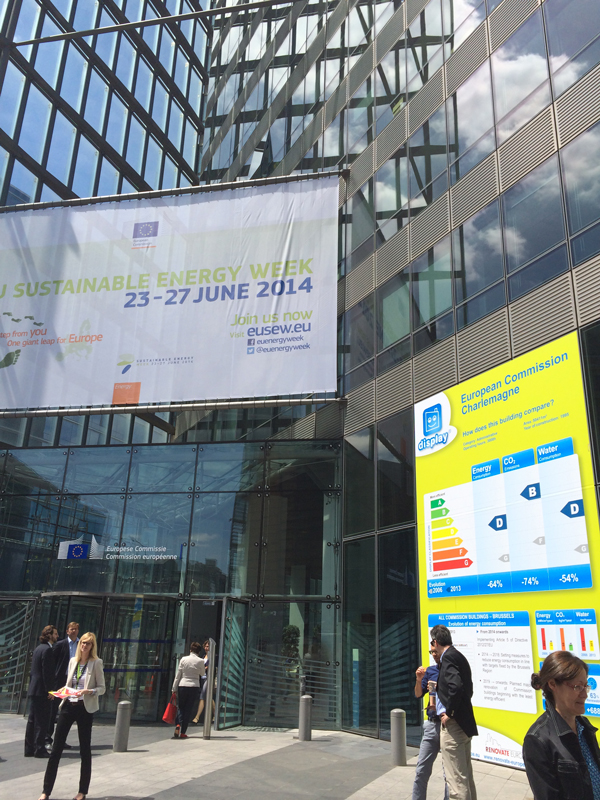 Giant-size Poster on Charlemagne Building reveals energy consumption of Commission buildings
Giant-size Poster on Charlemagne Building reveals energy consumption of Commission buildings
In partnership with Renovate Europe and Energy Cities, the Commission, though its Office for Infrastructure and Logistics in Brussels (OIB), will partake in a highly visible communication action during the EU Sustainable Energy Week (EUSEW – 23-27 June) by presenting a giant-size Display Campaign poster on the Charlemagne building highlighting the energy consumption of Commission buildings.
“The average energy consumption per square meter for the Commission buildings in Brussels has decreased by more than 30% between 2005 and 2013, which is more than 4% per year, and that is just the beginning!” explained Marc Seguinot, Head of Unit in the OIB, responsible for the management of the Commission's buildings. “Such significant results have encouraged us to go further, and we have planned for major renovation of Commission buildings from 2019. I hope this will inspire other public administrations to follow in the same lead”.
The recently adopted Energy Efficiency Directive (2012/27/EU) requires Member States to renovate 3% every year of their buildings owned and occupied by the central governments. The Commission has committed itself to reach the same result.
“This is a good example of a public administration which has put in place a coherent set of long-term energy efficiency measures to STOP energy waste in its buildings, and has reached a 4% reduction in energy consumption per year,” said Adrian Joyce, Renovate Europe Campaign Director. “The benefits of such energy savings are widespread: they will be felt through a reduced energy bill, but also through improved health and productivity for the buildings’ occupants, so it really is a win-win solution”.
As the EU takes strides towards reducing its energy dependence on foreign imports, Europe’s leaky building stock is increasingly coming under scrutiny, as buildings represent the largest energy consuming sector in the EU at a high of 43% of all energy consumed. It is possible to reduce the energy consumption of a large part of the building stock by 80% with currently available technologies.
“Citizens need to see that public institutions are not paying lip service to the energy transition but actually taking action. Everywhere across Europe, local authorities are driving this trend, with over 500 of them taking part in the Display Campaign. Close to 6,000 cities have committed to adopt ambitious sustainable energy action plans through the Covenant of Mayors, the Display Campaign is a useful communication and transparency initiative to support them along this path”, said Claire Roumet, Deputy Executive Director of Energy Cities.
The giant-size Display poster will be hanging on the Charlemagne building from 20th June until the end of EUSEW on 27th June. The OIB will provide additional information about the Commission’s buildings policy at the EuroACE EUSEW High-Level Policy Event “Quizzing the Stakeholders” on the morning of Wednesday 25th June in the Charlemagne.


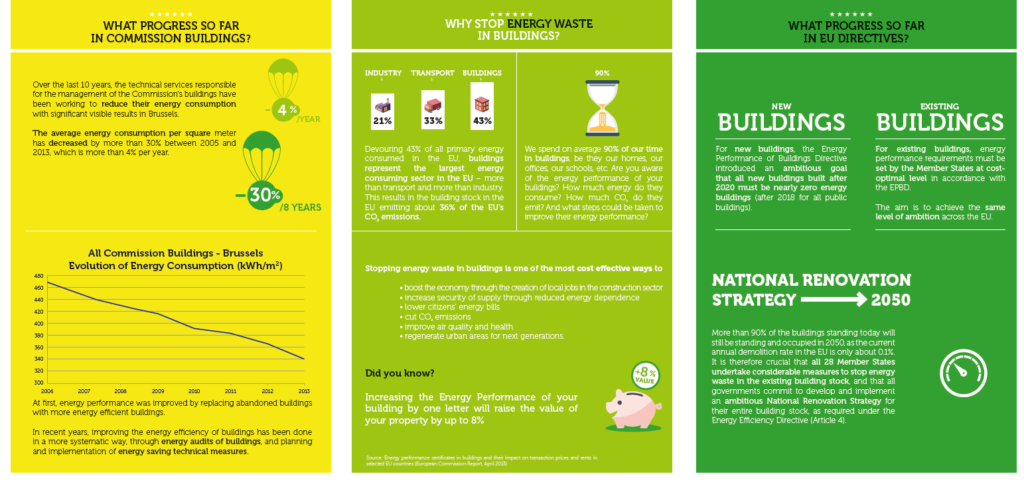
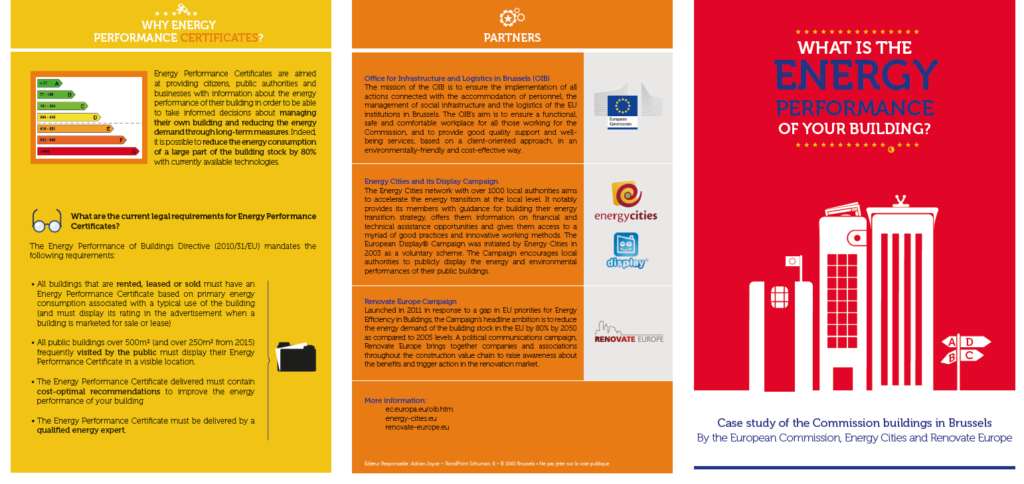
Giant size poster on Charlemagne Building reveals Energy Consumption of Commission buildings
In partnership with Renovate Europe and Energy Cities, the Commission, though its Office for Infrastructure and Logistics in Brussels (OIB), will partake in a highly visible communication action during the EU Sustainable Energy Week (EUSEW – 23-27 June) by presenting a giant-size Display Campaign poster on the Charlemagne building highlighting the energy consumption of Commission buildings.
“The average energy consumption per square meter for the Commission buildings in Brussels has decreased by more than 30% between 2005 and 2013, which is more than 4% per year, and that is just the beginning!” explained Marc Seguinot, Head of Unit in the OIB, responsible for the management of the Commission's buildings. “Such significant results have encouraged us to go further, and we have planned for major renovation of Commission buildings from 2019. I hope this will inspire other public administrations to follow in the same lead”.
The recently adopted Energy Efficiency Directive (2012/27/EU) requires Member States to renovate 3% every year of their buildings owned and occupied by the central governments. The Commission has committed itself to reach the same result.
“This is a good example of a public administration which has put in place a coherent set of long-term energy efficiency measures to STOP energy waste in its buildings, and has reached a 4% reduction in energy consumption per year,” said Adrian Joyce, Renovate Europe Campaign Director. “The benefits of such energy savings are widespread: they will be felt through a reduced energy bill, but also through improved health and productivity for the buildings’ occupants, so it really is a win-win solution”.
As the EU takes strides towards reducing its energy dependence on foreign imports, Europe’s leaky building stock is increasingly coming under scrutiny, as buildings represent the largest energy consuming sector in the EU at a high of 43% of all energy consumed. It is possible to reduce the energy consumption of a large part of the building stock by 80% with currently available technologies.
“Citizens need to see that public institutions are not paying lip service to the energy transition but actually taking action. Everywhere across Europe, local authorities are driving this trend, with over 500 of them taking part in the Display Campaign. Close to 6,000 cities have committed to adopt ambitious sustainable energy action plans through the Covenant of Mayors, the Display Campaign is a useful communication and transparency initiative to support them along this path”, said Claire Roumet, Deputy Executive Director of Energy Cities.
The giant-size Display poster will be hanging on the Charlemagne building from 20th June until the end of EUSEW on 27th June. The OIB will provide additional information about the Commission’s buildings policy at the EuroACE EUSEW High-Level Policy Event “Quizzing the Stakeholders” on the morning of Wednesday 25 th June in the Charlemagne.



